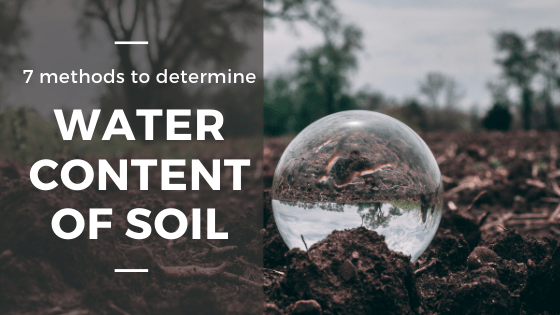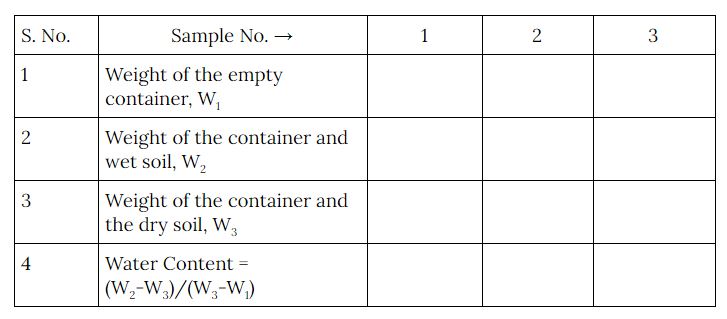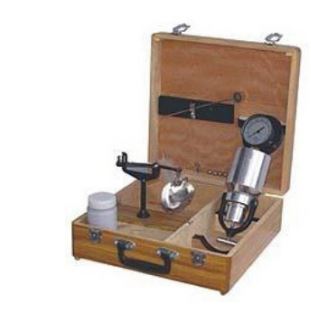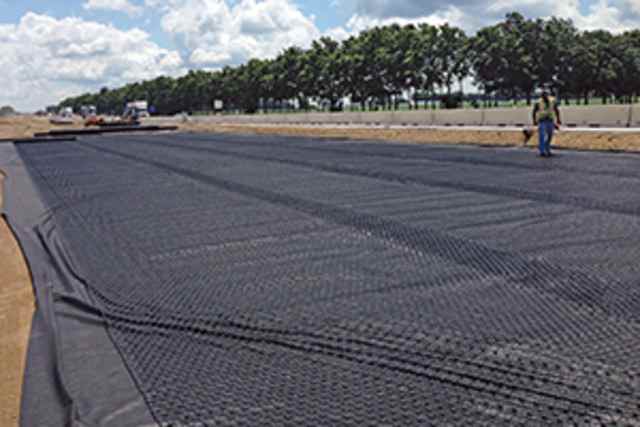The moisture content or water content of soil mass is a quantitative measure of the wetness of a soil sample.
Mathematically, water content for a given soil mass is defined as the ratio of the weight of water to the weight of soil.
Water Content, w = Weight of water / Weight of Soil
Importance of the Water Content of Soil
- The water content of soil can be used as the index property to indicate the behaviour and state of the soil.
- Some physical properties of soil such as bearing capacity, settlement, dry unit weight can be calculated when we know the water content of the soil sample.
- Since the water content of soil sample changes during its transportation and storage. Water content test should be the first test that is conducted immediately after it is received in the laboratory.
- The water content of soil can be determined accurately because it involves the measurement of weights only. (Weights can be measured more accurately than volumes)
Indian Standard Code dealing with the determination of water content of the soil is IS 2720 (Part 2)

Methods to determine the Water Content of Soil
The water content of the soil sample can be determined by any of the following methods:
Oven Dry method
The oven-dry method is the standard laboratory method for determining the water content of soil. It is a very accurate method.
Apparatus Required:
Air-tight container, Electric oven, weighing machine, Desiccator.
Note: Desiccator is the sealable container that is used to keep moisture-sensitive items to preserve their moisture content.
Procedure:
To determine the water content of the soil sample then we need to follow some following steps-
- Dry and clean the container. Measure the weight of the empty container (W1).
- Take the moist soil sample into the container and weigh it (W2).
- The soil sample is kept in the electric oven to dry at a temperature of 105-110 degree celsius for 24 hours.
- Finally, Record the constant weight of perfectly dried soil sample with the container (W3).
Observation and Calculations Table

Precautions:
- The temperature in the oven should not get more than 110-degree celsius because above this temperature, the water of crystallisation may be lost.
- Dry soil may absorb water from the moist soil, dried samples should be removed before placing wet samples in the oven.
Sand Bath method
Sand bath method is a field method to determine the water content of soil. It is a rapid but less accurate method.
Apparatus:
Sand bath, tray, weighing machine, palette knife (Spatula)., stove or spirit lamp
Note: A sand bath is a large, open vessel containing sand.
Procedure:
- Clean and Weigh the empty tray (W1)
- Take the soil sample in the tray. The sample should be crumbled and loosely placed in the tray. Put some pieces of white paper on the sample. Weight the tray with the wet soil sample (W2)
- Place the tray on the sand bath. The sand bath is heated over a stove for 20-60 minutes to dry the sample. The drying should continue till the sample attain a constant mass.
- During heating, the sample is turned with the palette knife. Overheating of soil sample should be avoided. The white paper turns brown when overheating occurs.
- After drying the sample is removed from the sand bath, cooled and weighed (W3)
Calculations:

Pycnometer method
Pycnometer method can be used only if the specific gravity of soil particles are known.
It’s a rapid method of testing a soil sample of known specific weight. This method is perfect for coarse-grained soil and it’s not perfectly applicable for fine-grained soil. The pycnometer is a bottle of size 900 mo and a brass conical cap is used for cover. The conical cap is screwed up with a bottle and a rubber washer is added inside the conical cap to prevent the leakage of water through walls of pycnometer and conical cap.
Apparatus Required:
Pycnometer, Tamping rod or vacuum tube
Note: Pycnometer is a glass jar of about 1-litre volume and fitted with a brass conical cap having a small hole at its apex.
Procedure:
- The clean and empty pycnometer with cap is taken and the weight is recorded (W1)
- Place 200-400 gm of the moist soil sample in the pycnometer and determine its weight (W2).
- Fill the remaining volume of pycnometer gradually with distilled water or kerosene.
- Remove the entrapped air either by heating and shaking the pycnometer or by applying a vacuum.
- Weigh the pycnometer with soil, water/kerosene (W3).
- Empty the pycnometer and after cleaning thoroughly, fill it with water/kerosene and take its weight (W4).

Calculations:
We this formula to determine the water content-
w = [(W2 – W1)/(W3 -W4) × (G – 1)÷G) -1 ]
Torsion Balance Method
Torsion Balance method is very useful for soils which quickly re-absorb moisture from the environment after drying. In this method, weighing and drying occur simultaneously. Torsion balance is calibrated to give water content directly
Apparatus Required:
Infrared lamp, Torsional balance.
Procedure:
- Keep the soil sample in the sample pan of the infrared lamp and spread evenly.
- Start the infrared lamp and keep the temperature under 110-degree Celcius.
- The water content can be read directly from the drum scale.
- When the pointer of the drum scale become stationary, it indicates the soil has dried (attained constant mass). This reading is the water content based on the dry weight (w’)
Calculations:
Water content, w = w’ / (1 – w’)
Alcohol method
It’s the same process of determining the water content like the oven-dry method, here the drying process is completed by methylated spirit.
Apparatus Required:
Air-tight container, knife, methylated spirit
Procedure:
- Take the weight of the clean and empty container (W1).
- Place the soil sample loosely in the container and weigh the container with soil (W2)
- Mix the methylated spirit (@ 1 mg per gm of soil) with the wet soil.
- Ignite the mixture. The mixed contents should be stirred by a knife to ensure complete drying.
- After that the methylated spirit is completely burned away, the container is cooled with desiccator.
- Take the weight of the container and the dried soil (W3).
Calculations:

Calcium Carbide method
Calcium carbide method is based on the principle that when water in soil sample reacts with Calcium carbide (CaC2), acetylene gas (C2H2) is produced. The water content of the soil sample can be found indirectly from the pressure of the acetylene gas formed, It is also called as Speedy or Rapid moisture test.

Apparatus:
Airtight containers, Calcium carbide, Dial gauge
Procedure:
- Take the soil sample in powdered form in the container and mix it thoroughly with the calcium carbide.
- The acetylene gas produced exert pressure on the diaphragm.
- The dial gauge is so calibrated that it gives the water content of soil directly based on the total mass (wt).
Calculations:
The water content of the soil sample based on the dry mass is determined as:
w = w’ / (1 – w’)
Radiation Method
Radiation method is used to determine the water content of the soil in in-situ conditions.
Apparatus Required:
Steel Casings, Emitters, Detectors, radioactive material (Cobalt 60)
Procedure:
- The device containing a radio-active isotopes material (such as cobalt 60) is placed in a capsule.
- It is then lowered in a steel casing, placed in a borehole. The steel casing has a small opening on its side through which rays come out.
- A detector is placed inside another steel casing, which also has an opening facing the first casing.
- Neurons are emitted by radioactive materials. The water of soil cause loss of energy as a result of scattering of neutrons by hydrogen atoms.
- The loss of energy is proportional to the quantity of water present in the soil. The detector is calibrated to give the water content directly.
Precautions:
The radiation method should be used carefully as it may cause the radiation problem. Therefore proper shielding should be ensured.
Report of the Water Content Test
The report of the water content test of soil should contain:
- Details of the soil sample
- The method of test used.
- Result: moisture/water content. It should be reported to two significant digits.
- The temperature at which the soil is dried.
Also Read: Geotechnical Investigations


very good